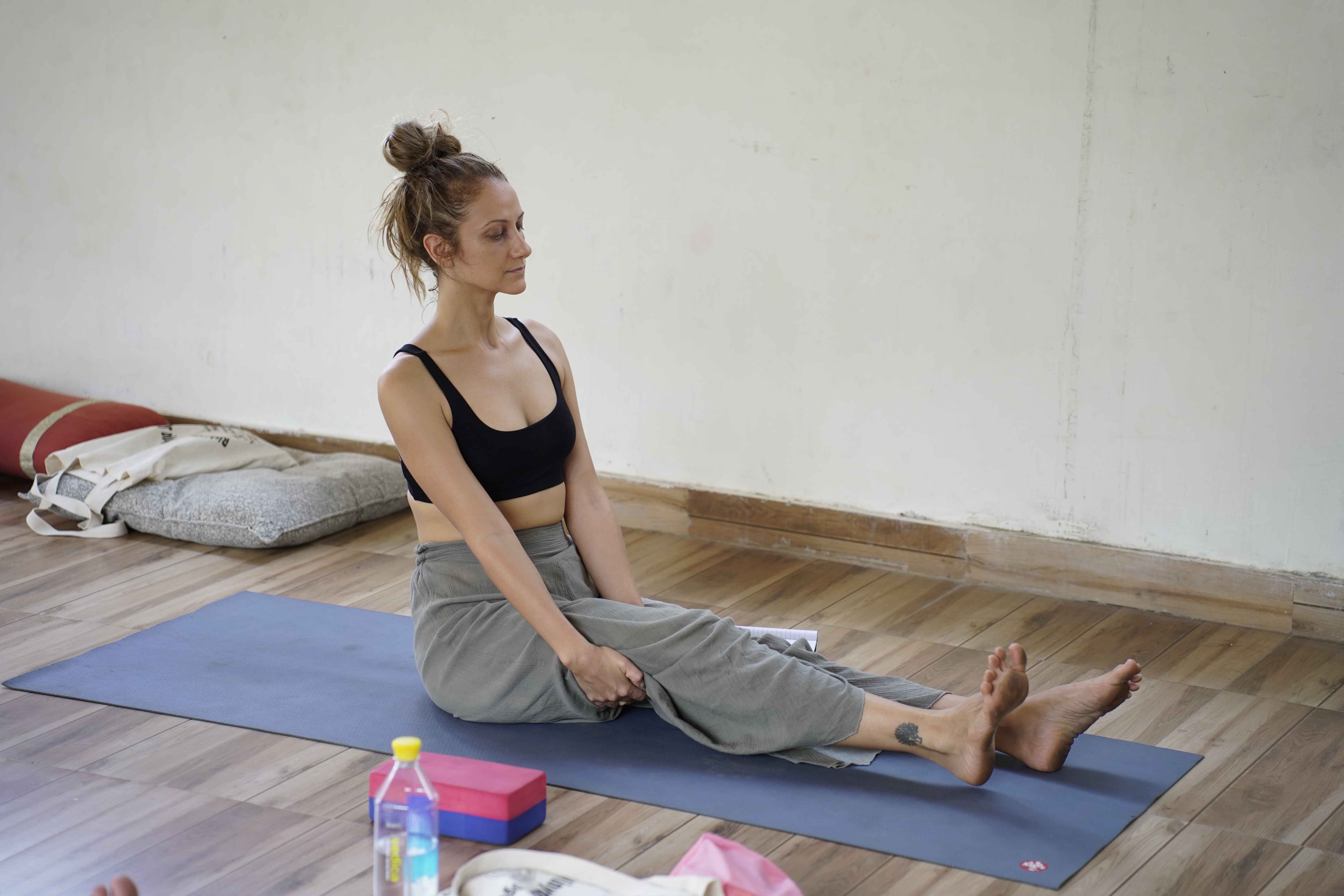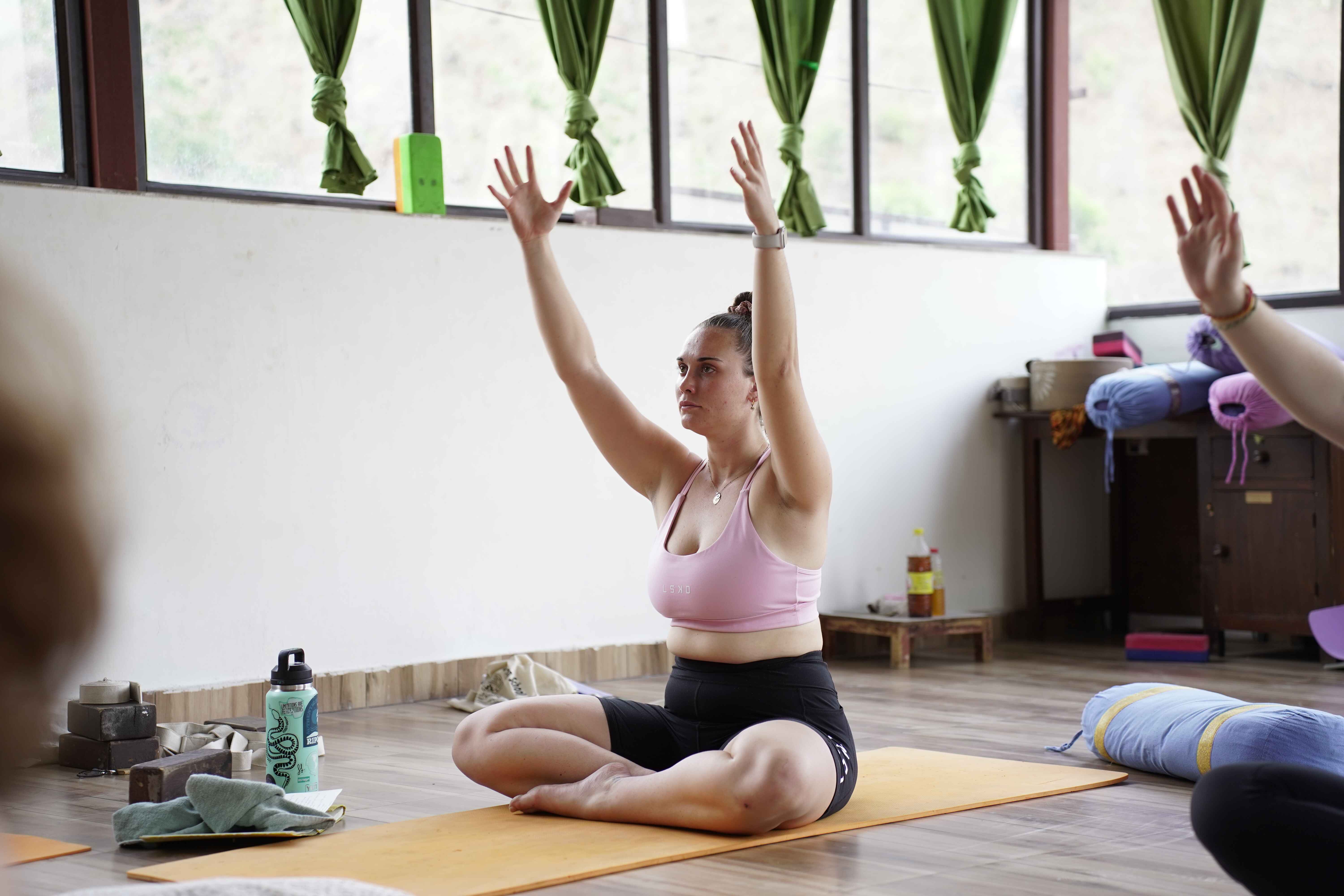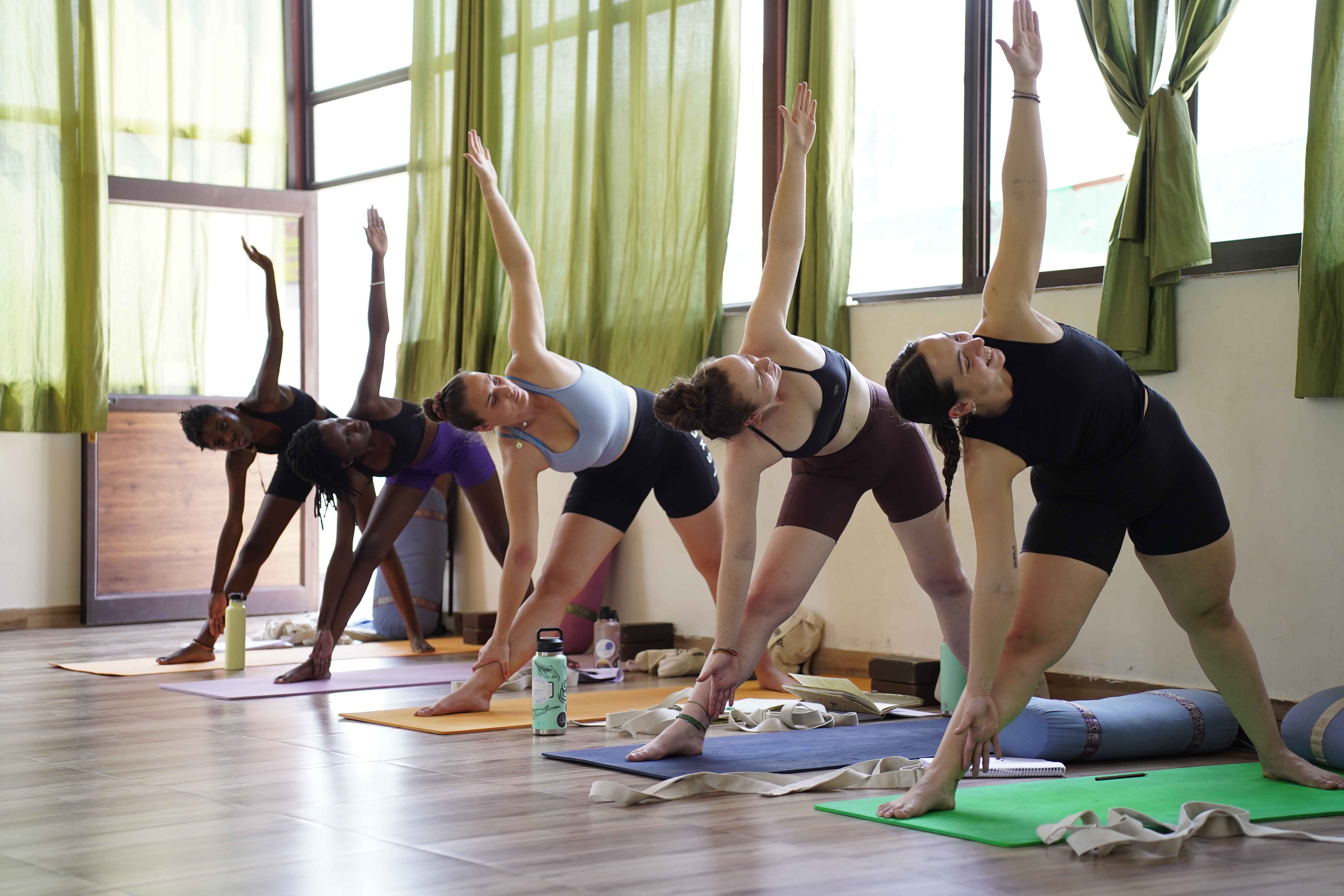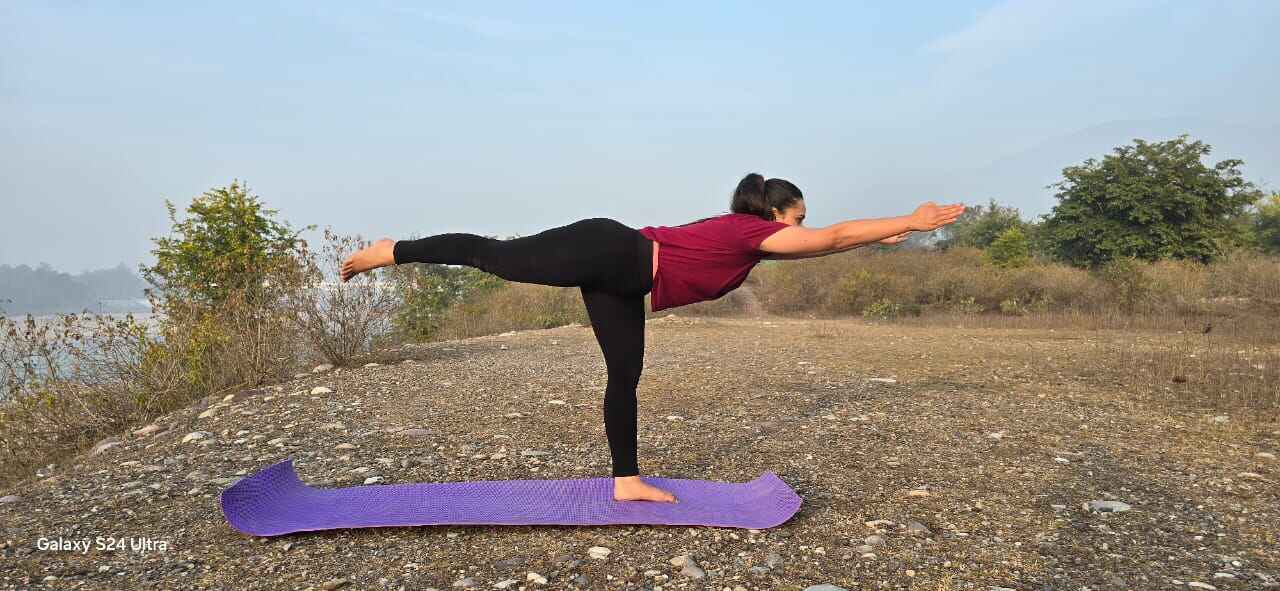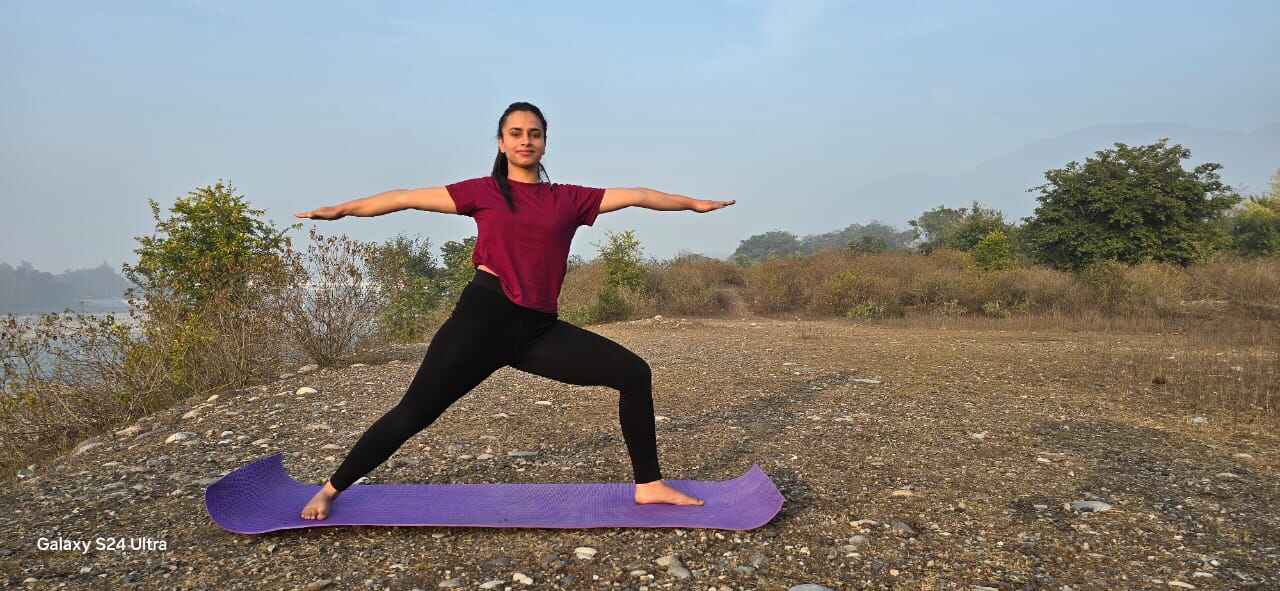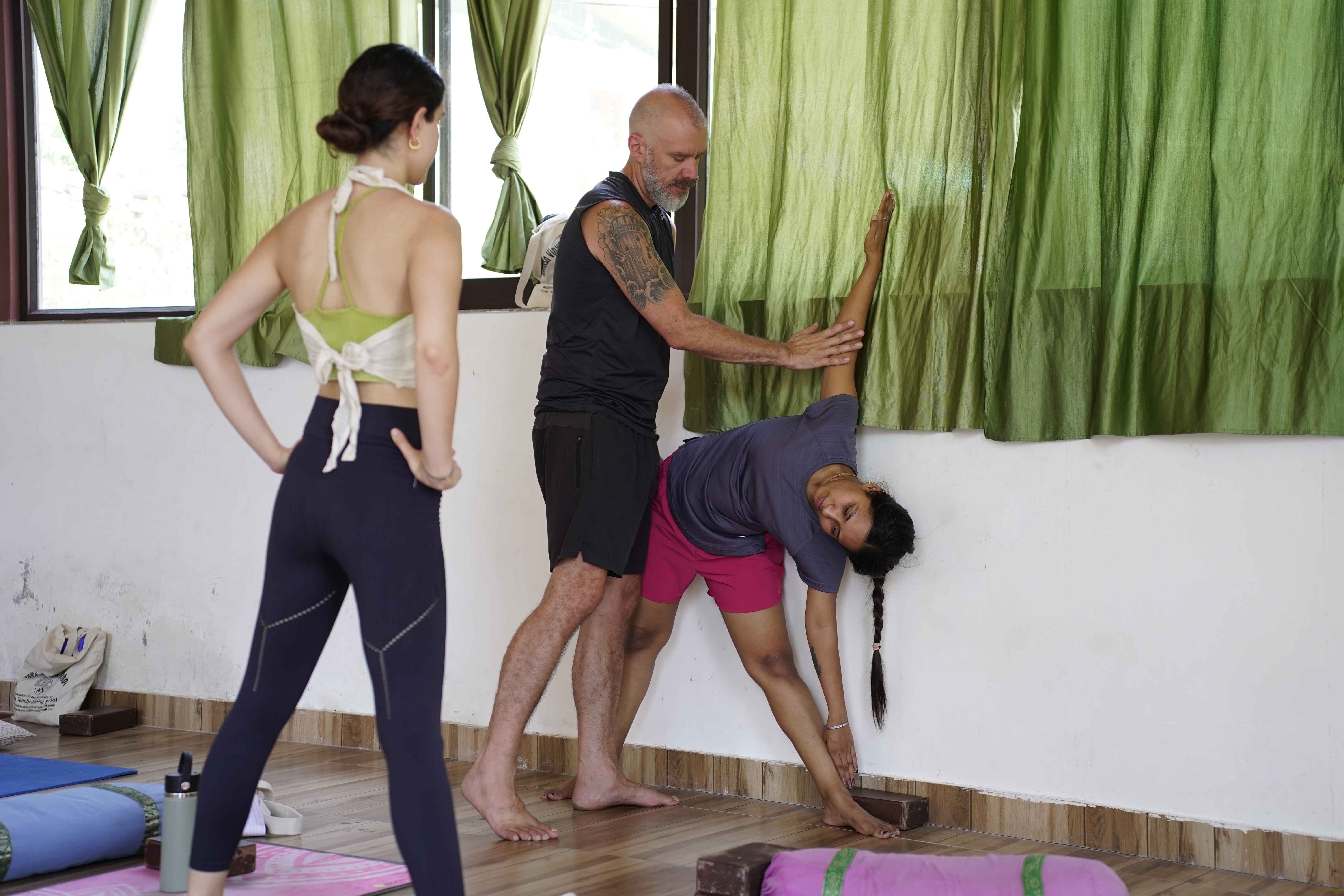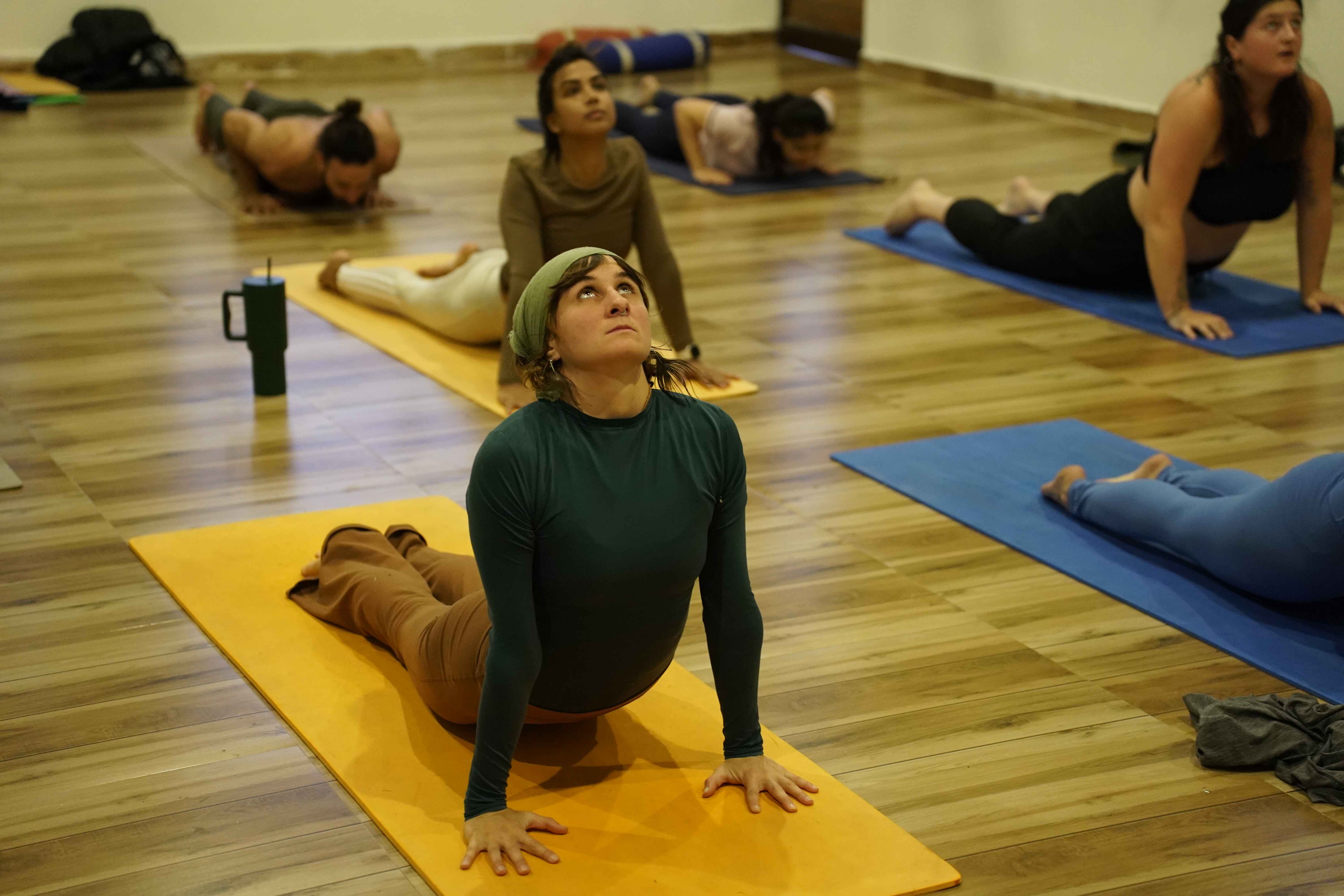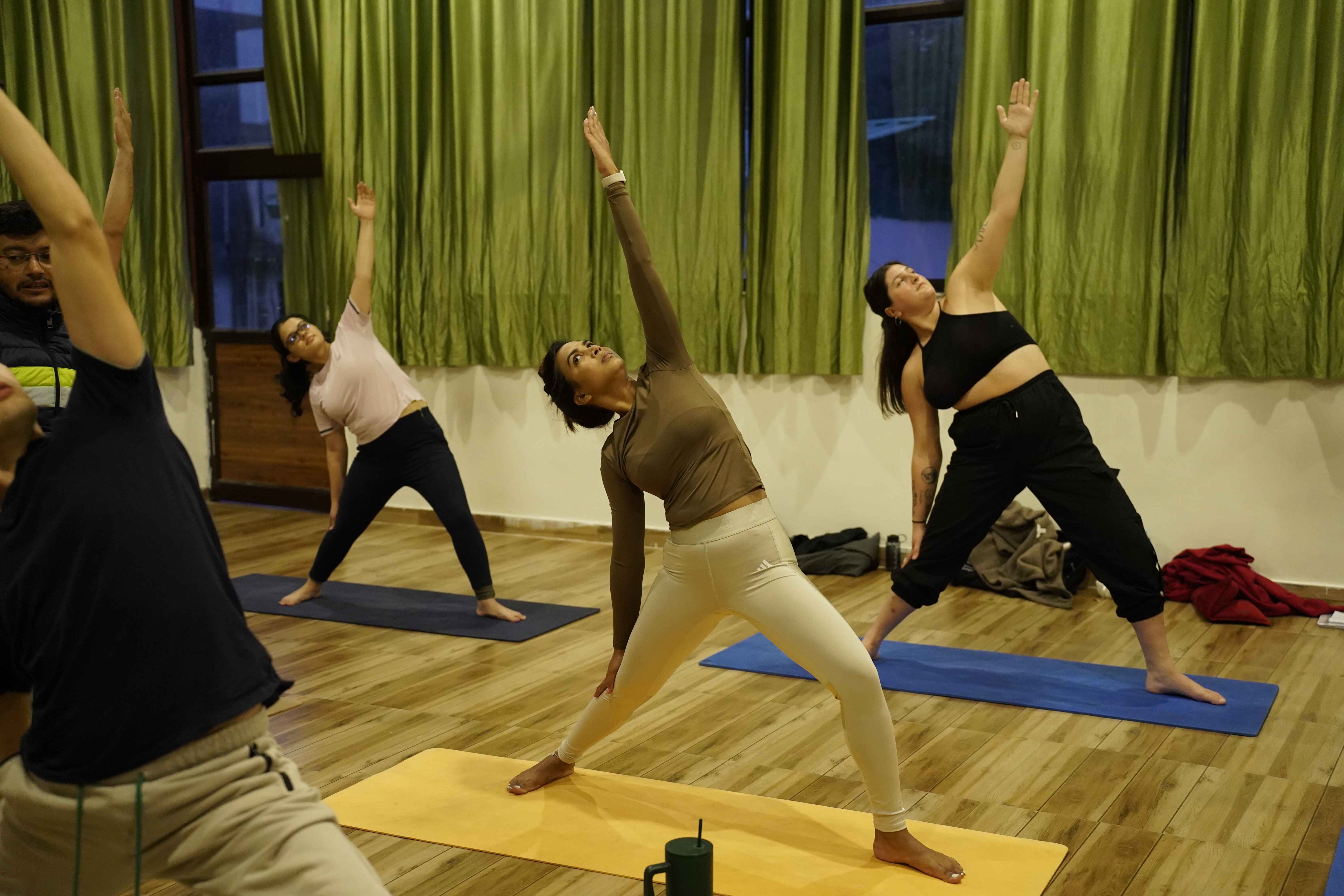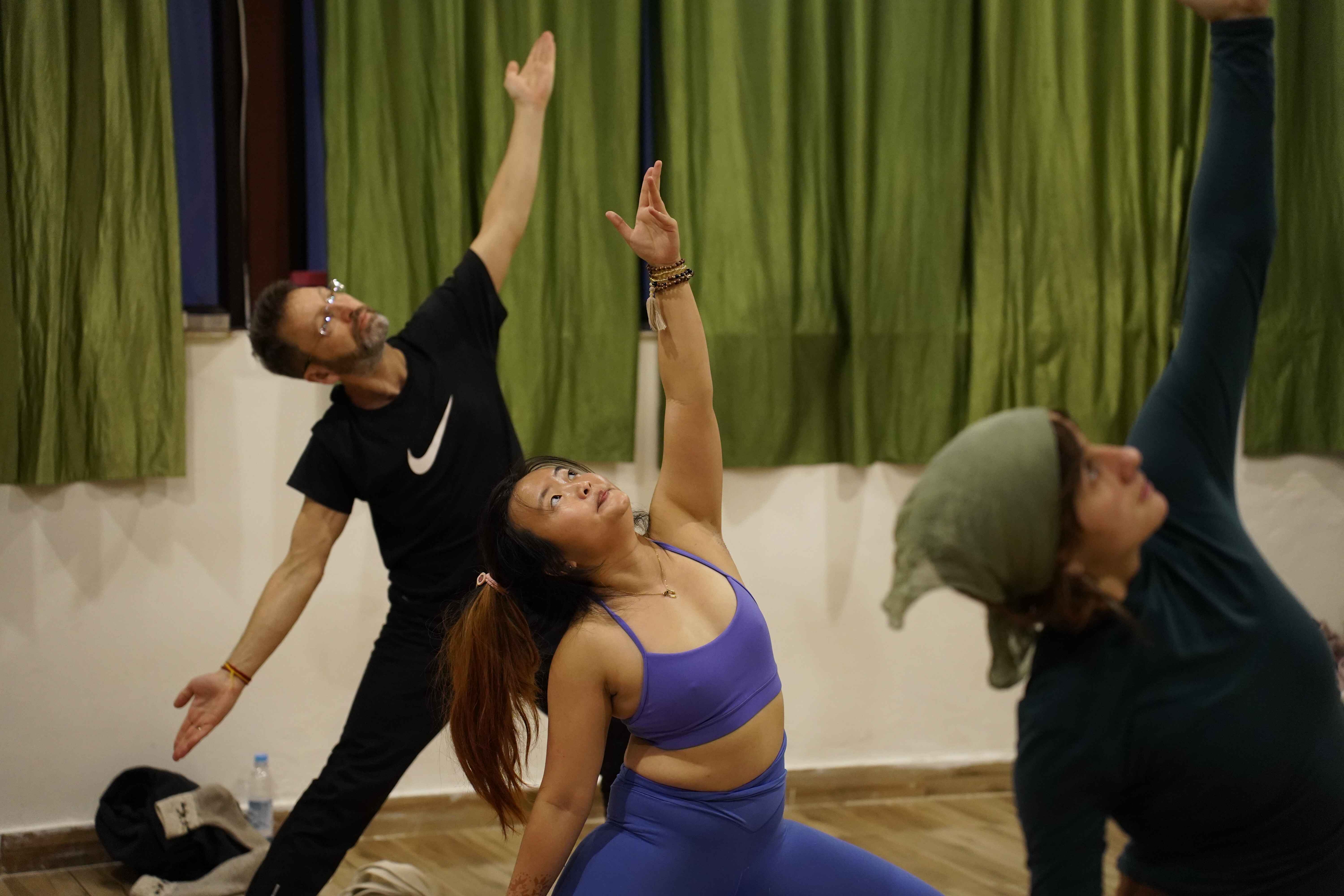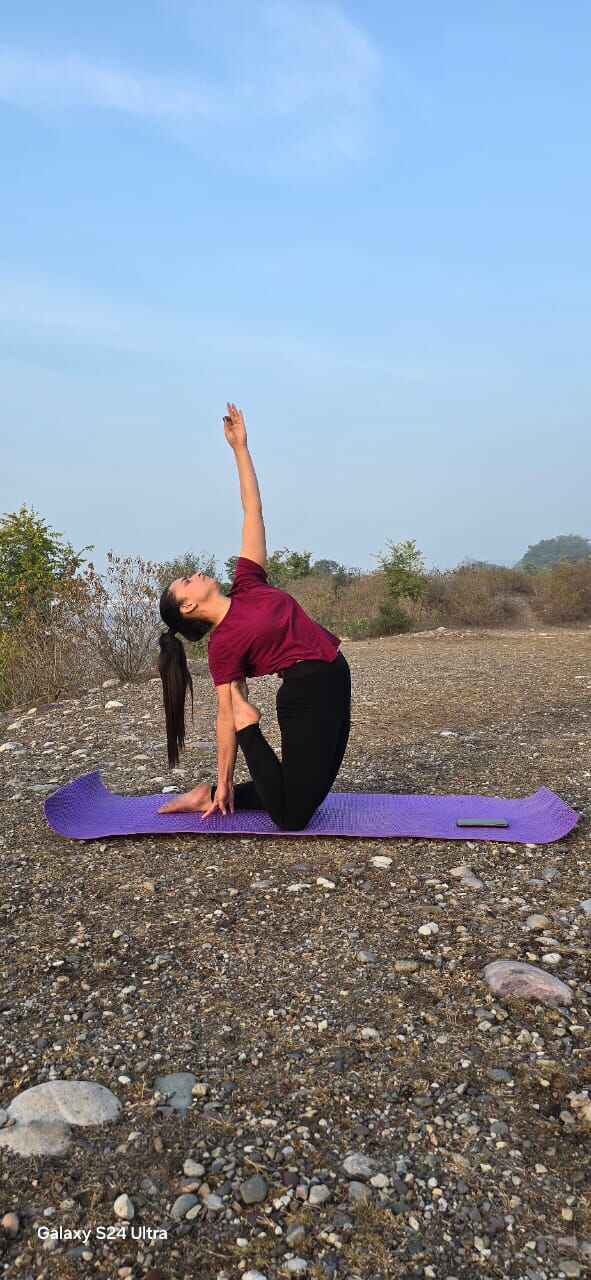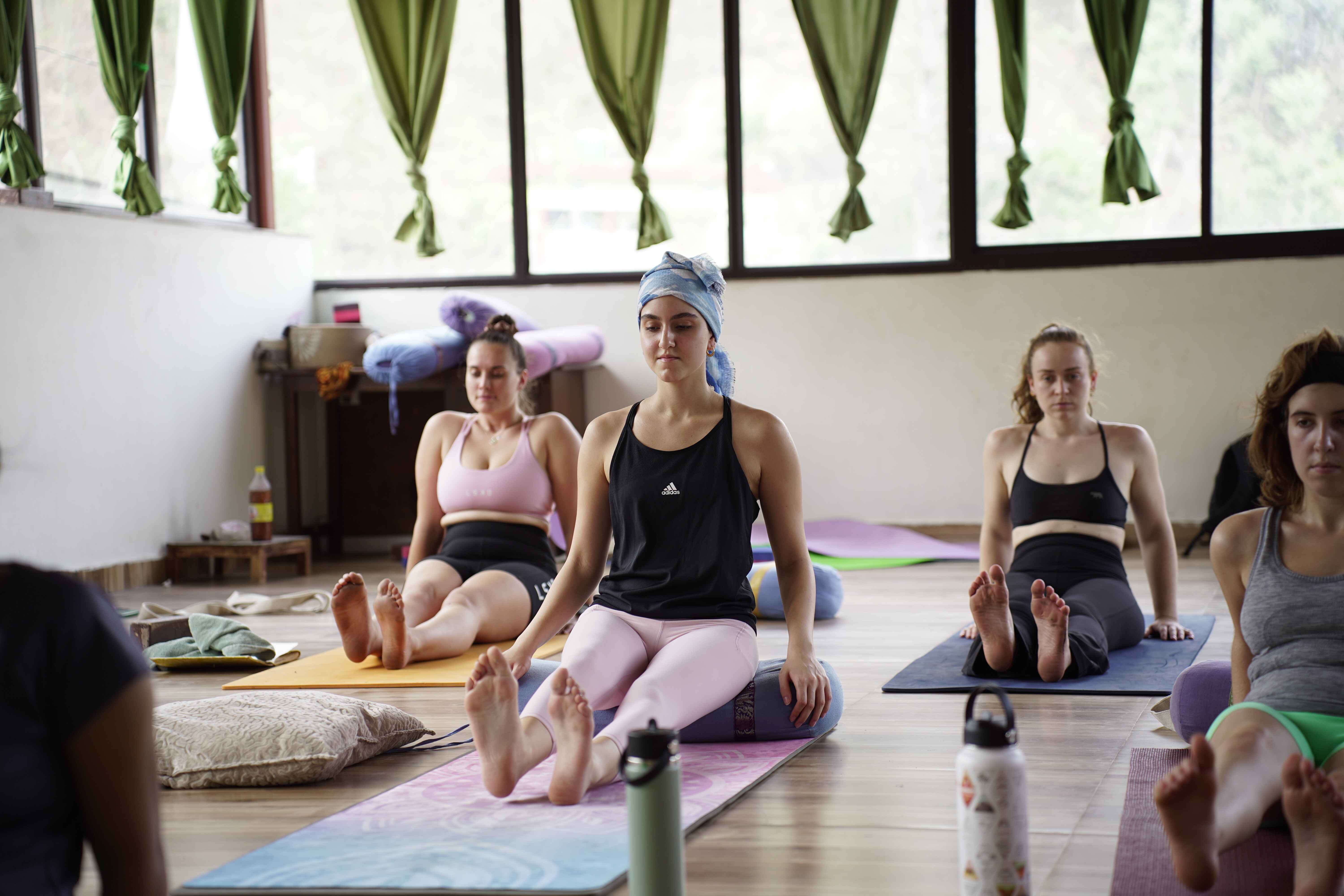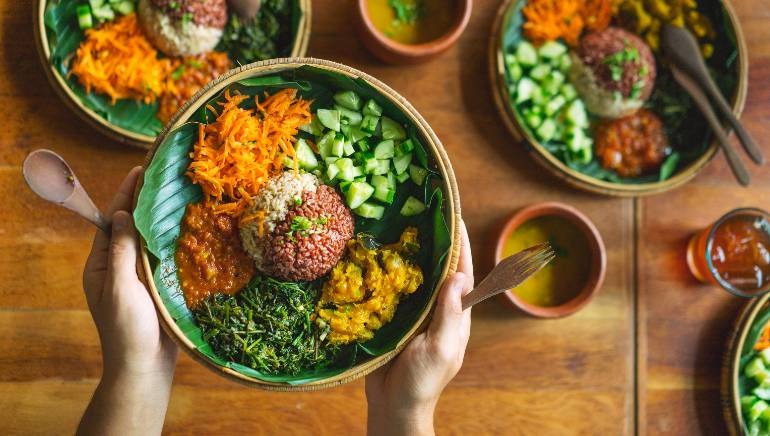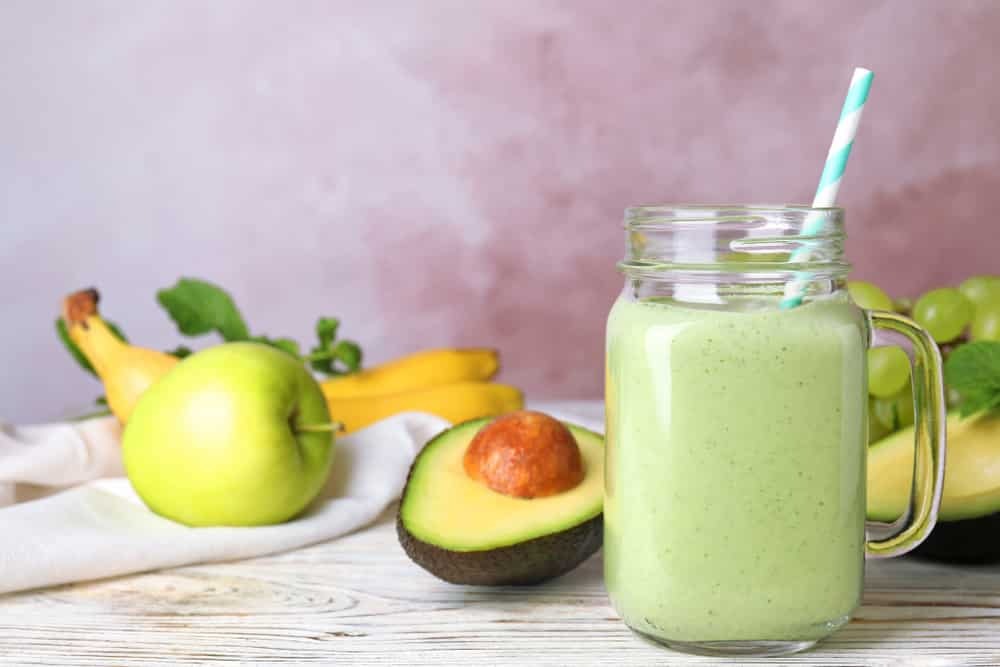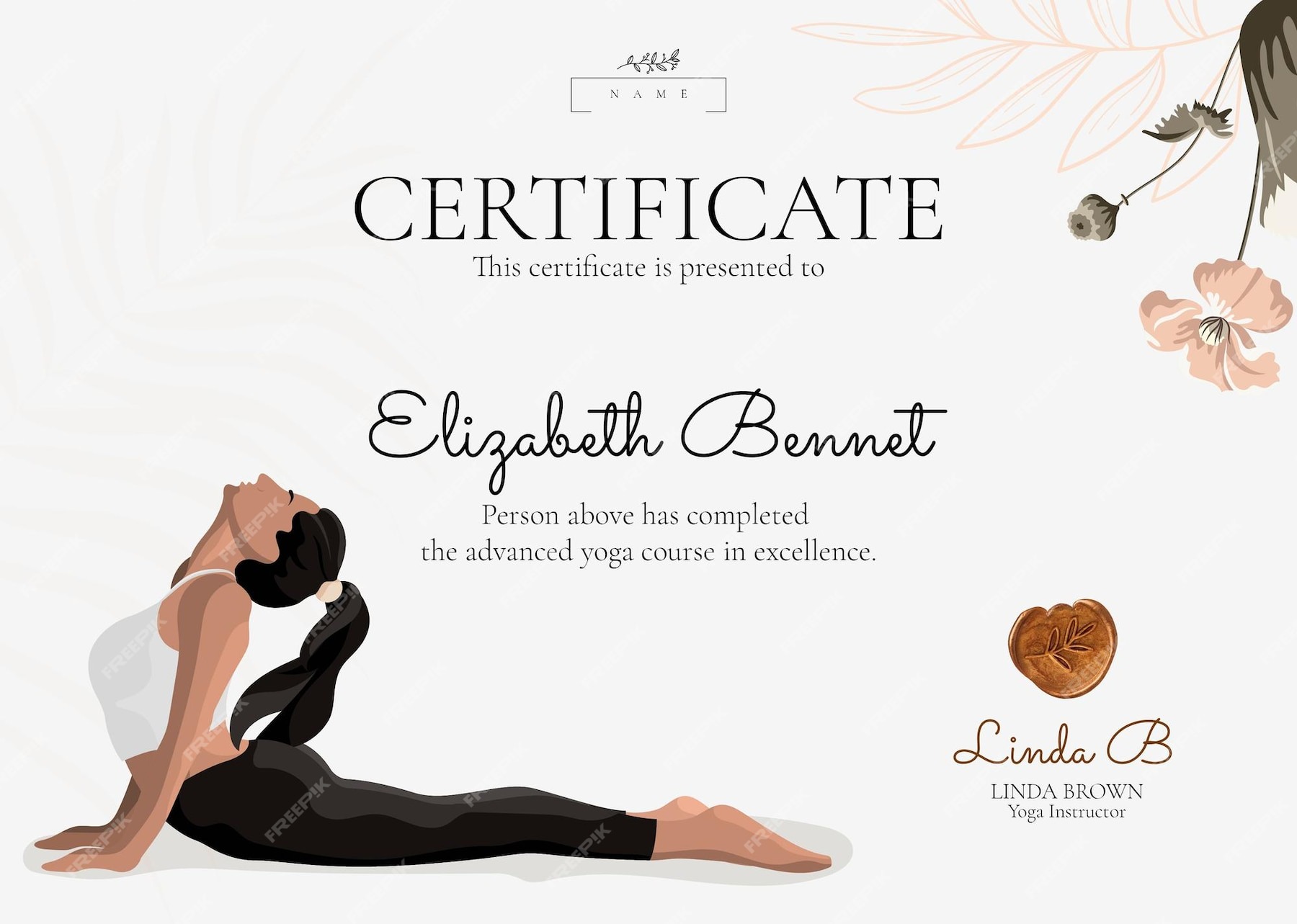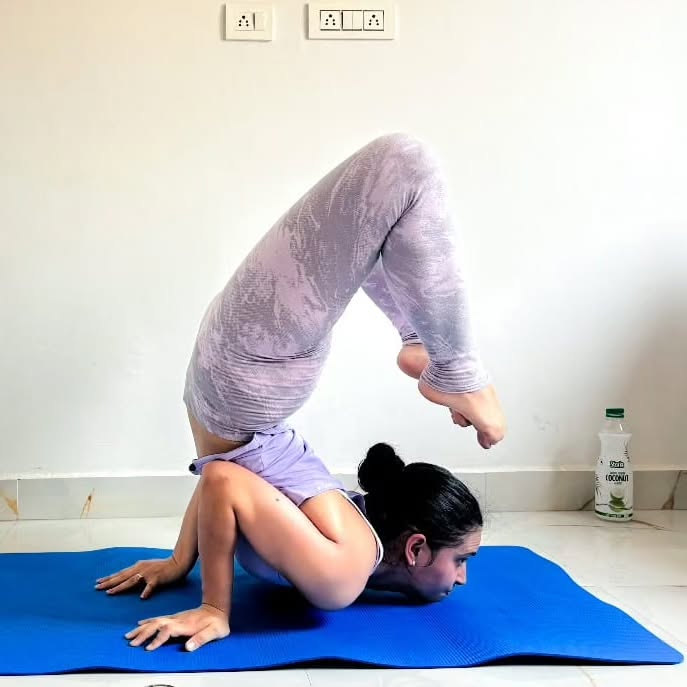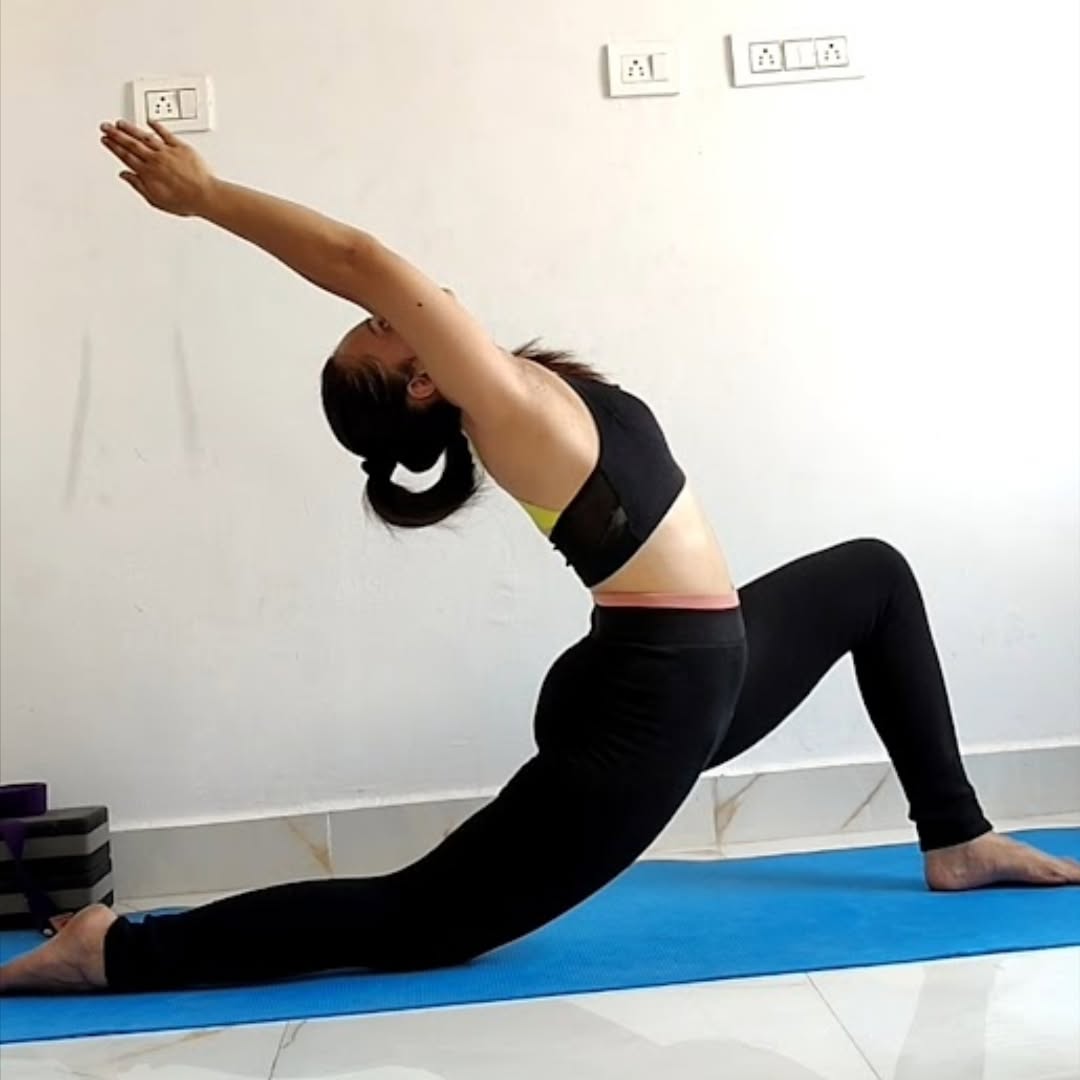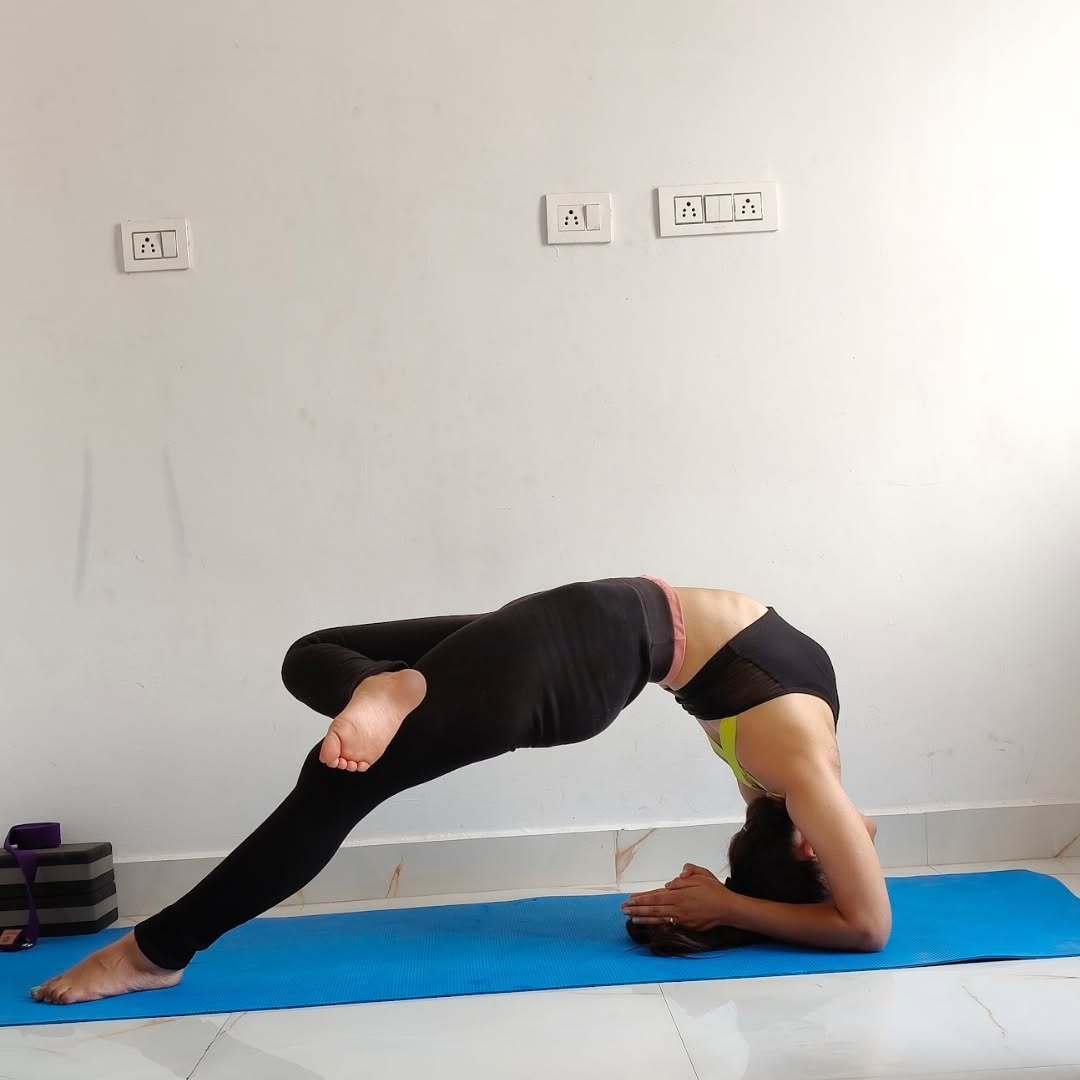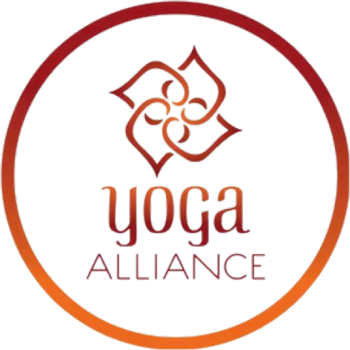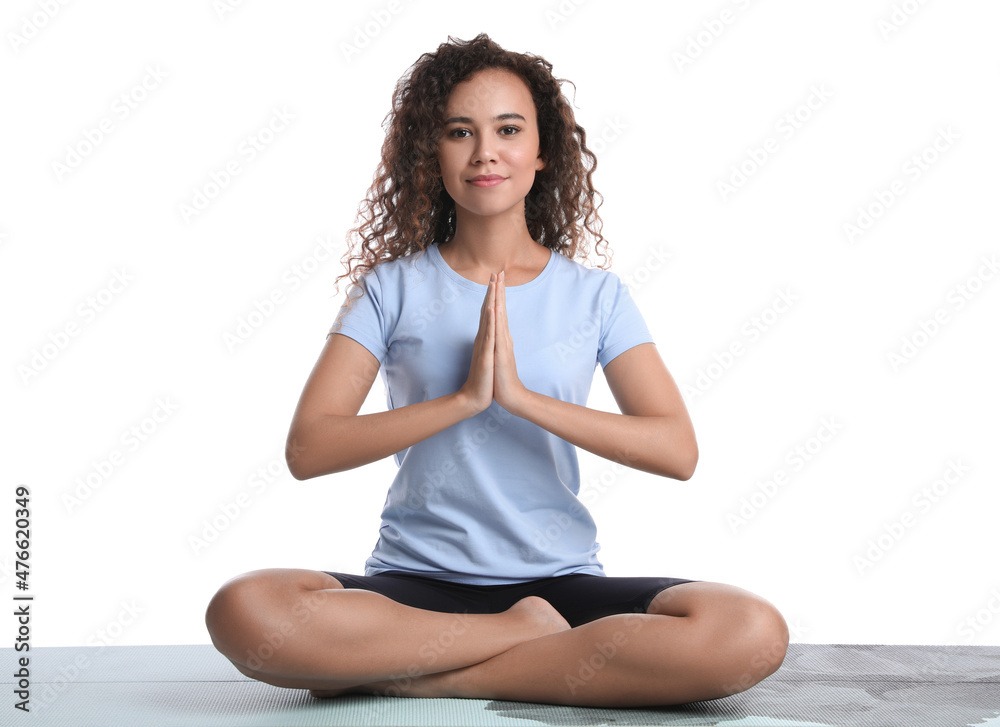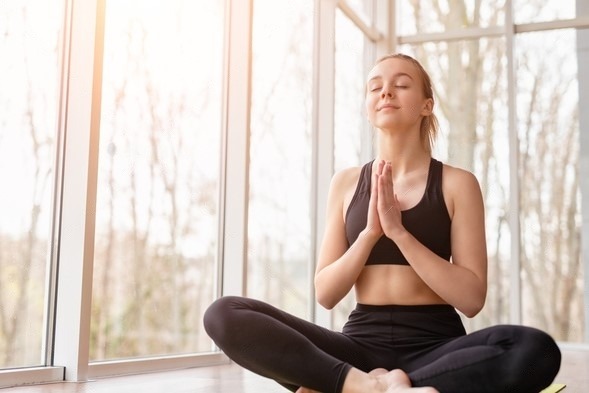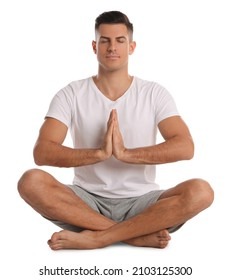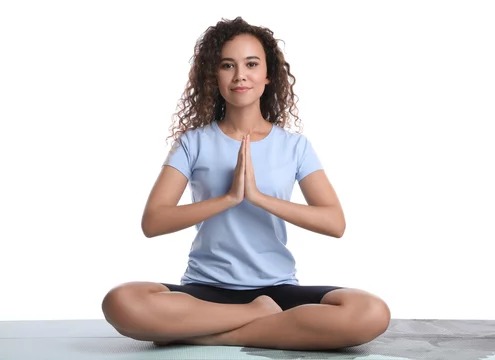Techniques
Herein you will receive training of asanas, pranayama, kriyas, mantras & meditation in a practical
and analytical way. Following a scientific approach, we will discuss physical and energetical health benefits. Subsequently, you will learn to recognize practice mistakes to focus on alignment. Find some syllabus examples for this block outlined in the following: Standing Postures
Standing Asanas
Asanas stretch and strengthens back, shoulders and leg muscles. This is especially important to relieve stiffness and back pain difficulties, which increasingly arise in modern times through long hours of sitting. In this section you will learn common standing postures, how to explain their benefits, and experience their balancing effects on the root chakra. We will further discuss how to provide effective verbal
cues to direct practitioners coming in and out of the poses, how to verbally adjust, and how to breathe properly.
ii. Bending Postures:
Bending asanas loosen the back by separating vertebras and improve blood circulation around the spine. This brings vitalizing and overall health improving effects on all organs and the brain. You will receive analytical training by demonstration, conversation and the use of the TTC guidebook in how to teach, practice and adjust bending postures. The learning objects herein are to explain bending postures and their benefits; verbalize and demonstrate alignments; be aware of common misalignments and risk factors;
learn how to direct practitioners coming in and out; and how to breath in these positions.
By following along with our instructor in this course you can expect:
- Better range of motion/li>
- Strong feet/balance and grounding (in life)
- More endurance in standing
- Improvement in the arches
- More agility (in both mind and body)
- Improved sense of well being
iii. Pranayama:
Pranayama is considered to be the foundation of yoga. It is perhaps the most essential aspect of yoga and life.
Pranayama is the best precursor for calming and centering the mind for meditation. Pranayama regulates prana flow in the
nadis of the pranamaya kosha. Through practice, observation, and discussion you will learn most common breathing techniques,
how to explain benefits, and how to direct practitioners through these exercises. We will also practice pranayama on occasional
spiritual trips and breath the fresh air in the mountains or on the rocks by the sea shore. Learning objectives are to get
an overview and practice experience of multiple pranayama techniques and learn to use powerful breath workout and pranayama
techniques to: detoxify your body, balance hormones, boost immunity and energy, calm the mind, awaken your full potential
to discover the true nature of the self, and brings you deeper into the yoga practice. When the mind is focused on the
breath, the nervous system gets calmed down, and there is less stress on the body and it experiences better digestion and
elimination. Regular practice of pranayama trains the lungs and
improves the capacity of the respiratory system immensely (especially important during these covid times).
iv. Mudras Relevant To Pranayama
These are some of the most common hand mudras in pranayama practice
- Nasikagra mudras (nose tip position)
- Jnana mudra (psychic gesture of knowledge)
- Chin mudras (psychic gesture of consciousness)
-
Chinmaya mudra (gesture of manifest consciousness)
- Aadi mudra (primal or first attitude)
v. Mantra Yoga Sadhana:
According to Samkhya, one the schools of Hindu philosophy, the very first element
that manifested itself in this plane was sound and that the element of sound itself
originated from Lord Shiva’s Drum. Sanskrit mantras are energy-based sounds that have
the power to vibrate and resonate throughout the entire body. Sound travels five times
more efficiently through water than through air, and as the human body is comprised of
more than 70% water, it is therefore an excellent conductor for both sound and vibration.
The regular practice of mantras especially balance the agitations of manomaya kosha. Once a week we hold a
Yajna yoga in the evening time with a puja with meditation, mantras, breathing techniques and offerings.
vi. Meditation
- What meditation is, and why it’s practiced
- Variety of meditation techniques and tools
- Quieting the mind to develop deeper levels of awareness
- Connecting with nature and the world you live in
- Connecting with the true Self
II: Teaching Methodology:
In this section, classes will address how to use verbal and physical hands-on adjustments, how to give clear and coherent instructions, how to sequence classes, how poses interact and how to integrate breathing exercises.
The Art of Teaching curriculum includes:
- Teaching clinics
- How to address a group of students
- How to use your own body as a teaching tool
- How to use your voice, volume, tempo, and pacing
- How to correct postures
- Choosing the right words
- Energy, passion, confidence, humor
Using your own presence and Self-awareness as a transformative teaching tool
- The Business of Yoga
- Teacher guidelines & etiquette
- Appropriate conduct inside and outside the yoga room
- How to apply for a teaching position
- Teacher expectations
- Student interaction
- Role playing
- Feedback
III: Anatomy & Physiology
Herein you will broaden your understanding about the physical anatomy of the
human body and combine important aspects of postures and anatomy with contemplative
and internal facets of yoga. Next to physical anatomy, we will
go deeper into the realms of energy anatomy of Chakras, Kunadlini, Gunas, Tattwas, Koshas, Nadis & the Vayus.
Yoga Posture & Alignment
- How your bones determine the range of motion in all the yoga postures.
- How and why everyone does yoga postures differently and what they can do about it.
- How joint compression and muscle tension or resistance plays role in all the yoga asana.
- Learn muscular and skeleton restrictions for proper alignment.
- How to improve yoga posture for individuals
Yoga Posture & Alignment (details)
- Introduction and concept
- Applied yoga anatomy
- Connective tissue and muscle role in movements
- Bones and joints function in movements
- Kinetic chain movements and their role in movements
- stability and mobility drills
- Wrist and elbows testing and assessments
- Injury prevention and corrective alignment for wrist and elbows in arm balancing and loading postures
- Palm stability and its importance in balance postures
- Wrist joint anatomy, health, function, and purpose
- Elbow joint anatomy, health, function, and purpose
- All related yoga postures to experience with muscle control including but not limited to crow pose, [peacock pose,
pendant pose, high plank, reverse plank, upward-facing dog, downward-facing dog, and much more
- Shoulder and scapula testing and assessments
- Injury prevention and corrective alignment for shoulders and scapula in arm balancing and loading postures
- Shoulder joint anatomy, health, function, and purpose
- Scapula blades anatomy, health, function, and purpose
- All related yoga postures to experience with muscle control including but not limited to Chaturanga, wheel pose, king pigeon,
intense side stretch pose, cow facing pose, eagle pose, puppy pose, and much more
- Cervical spine testing and assessments
- Cervical spine anatomy, health, function, and purpose
- Injury prevention and corrective alignment for neck joint in inversions and neck flexion or extension postures
- All related yoga postures to experience with muscle control including but not limited to plow pose, shoulder stand, ear pressure pose, fish pose, bridge pose, headstand, and much more
- Thoracic and lumbar testing and assessments
- Thoracic spine anatomy, health, function, and purpose
- Lumbar spine anatomy, health, function, and purpose in backbends
- Injury prevention and corrective alignment for the thoracic and lumbar spine in backbends or extensions postures
- All related yoga postures to experience with muscle control including but not limited to locust pose, cobra pose, crocodile pose, bow pose, bridge pose, wheel pose, camel pose,
upward-facing dog, low lunge backward bend, pigeon pose, backbend standing, and much more
- Sacroiliac joint, lumbar, and Pelvis testing and assessments
- S. I. joint anatomy, health, function, and purpose
- Lumbar anatomy, health, function, and purpose in flexion or forward bends
- Pelvic anatomy, health, function, and purpose
- Injury prevention and corrective alignment for S.I. joint, lumbar, and Pelvic in forwarding bends
- All related yoga postures to experience with muscle control including but not limited to Marichi asana, twisting postures, revolved side angle, revolved triangle, revolved half-moon, supine spinal twists, standing twists, Paschimottanasana, Janusirsasana,
Pawanmuktasana, Hanuman asana, wide-angle forwards fold, Uttanasana, and much more
- Hip joint testing and assessments for all movements (flexion, extension, abduction, adduction, internal and external rotation)
- Hip joint anatomy, health, function, and purpose
- Injury prevention and corrective alignment for the hip joint in all yoga postures
- All related yoga postures to experience with muscle control including but not limited to deer pose, Baddhakonasana, single-leg sitting balance pose, frog pose, Goddess pose, triangle pose, warrior one
pose, warrior two pose, warrior three pose, side angle pose, and much more
- Knees and feet
- Knee joint, ankle, and foot testing and assessments
- Knee joint anatomy, health, function, and purpose
- Ankle joint anatomy, health, function, and purpose
- Foot joint anatomy, health, function, and purpose
- Injury prevention and corrective alignment for the knee joint, ankle, and foot
- All related yoga postures to experience with muscle control including but not limited to Padmasana, Vajrasana, Veerasana, Tadasana, Trikonasana, Utkatasana, Veerbhadrasana one and two, high lunge,
Supta Vajrasana, Malasana, tree pose, eagle pose, single-leg toe hold pose, and much more
Yoga Philosophy, Lifestyle Ethics & Ayurveda
A yogic lifestyle is a journey to create unity on all levels. This means to live every day consciously,
with a focused, calm mind, seeking inner perfection at all times. This teacher training places an emphasis
on studying the vast heritage of yoga philosophy. By introducing the Samkhya system of evolution and discuss
traditional texts (such as the Yoga Sutras by Patanjali) we will explore the eight limbs of Ashtanga Yoga in
more detail and take a glimpse beyond the first limbs towards the ultimate goal of yoga. Next to getting
inspiration from these sacred texts, it may make us recognize the importance of a firm foundation in these
first limbs, as prerequisite to progress on this path of liberation -and how you, as prospective yoga teachers,
can assist other beings along this journey. We are looking forward to inspiring conversations about the precept
of non-violence (ahimsa), the concepts of dharma and karma, and finally the value of teaching yoga while being of
service to others (seva).
Ayurveda
Ayurveda is the science of living. Our practice depends on us being in balance. Through an
understanding of Ayurveda, we learn about our bodily constitution, and what kinds of diets
and lifestyles are most suitable to one’s character. Our Ayurvedic Doctor will teach you about
the theoretical basics of Ayurveda, helping you to discover a diet fitting to your type of body
and individual needs and intellectually understand the positive effects of the high qualitative
sattvic yogi diet you are served throughout the TTC. If you like to relax from the training, you will be delighted to find
the yoga studio surrounded by several skilled ayurvedic massage salons.
V: Practicum
In this section, you will be slowly prepared to lead a yoga class yourself. In the beginning you will
start to teach sun salutations and simple sequences to each other. With your peers, you have fun
together learning and supporting each other in this yogic growth process. In the progress of your
training, you will then start to observe and correct and finally practice teaching as the lead
instructor and participate with others teaching. Awaken your practice to this 28-day yoga challenge
that will inspire you to step on your mat every day. The benefits of practicing yoga everyday can
be felt almost immediately. At the end of the month, you’ll complete the challenge feeling stronger,
more connected, and more empowered in your practice. You will gain an understanding of the specific
teaching skills needed to make the learning experience for your students as easy as possible. We also
give lots of contact with (Props) to aid in the Skill-Based Mobility (for range of motion),
and Restorative (for calm and recovery) practices. Yoga props are extremely useful in helping to
create sthira (steadiness) and sukha (comfort) in your yoga practice. By no means limited to beginners,
props help to accommodate anatomical differences, tight muscles/joints, and limited ranges of motion.
If you’ve ever wondered how to efficiently use props in your home or studio practice, we provide an
introduction to the accoutrements that could bring your asana practice, the union of body, mind, soul,
and spirit.
Continuing Journey Of Yoga: Reflection On The Process Of Becoming A Yoga Teacher.
- Reflection on the Process of Becoming a Yoga Teacher
- Discussion on what Certification Provides
- Code of Ethics
- Yoga Alliance Registration
- Group conversation about options for teaching and sharing
- Discussion about how to maintain appropriate skill and inspiration
